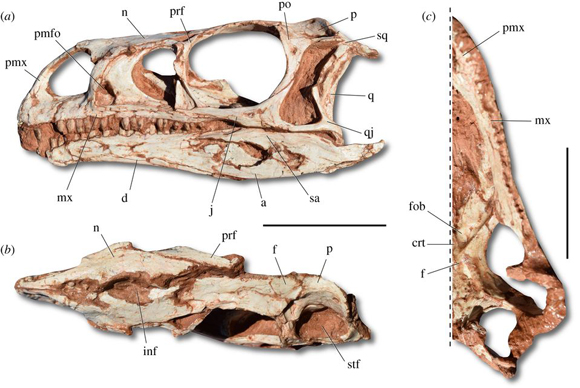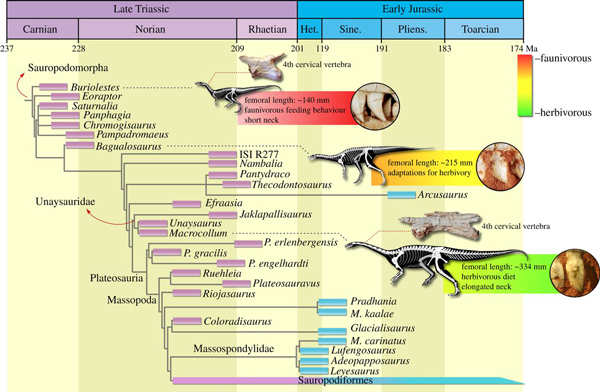How Did Some Dinosaur Get Their Long Necks?
Macrocollum itaquii – Oldest Long-necked Sauropodomorph is Described
A team of scientists based in Brazil have described the fossilised remains of three Triassic dinosaurs that lived some 225 million years ago that shed light on the evolution of long-necks in plant-eating dinosaurs. The new species, a member of the Sauropodomorpha, has been named Macrocollum itaquii, the genus name comes from the Greek for “long neck”, an appropriate moniker for a prehistoric animal that is helping to unravel the developmental history of the long-necked dinosaurs bauplan.
Macrocollum itaquii
Although Macrocollum is estimated to have measured about four metres in length and weighed approximately 100 kilograms, a lot smaller than later sauropods, some of which were the largest terrestrial animals to have ever lived, it is considerably bigger than older dinosaur fossil specimens found in South America, some of the earliest dinosaurs known, that lived around ten million years earlier and represent some of the very first dinosaurs to evolve.
A Life Reconstruction of Macrocollum itaquii
Picture credit: SWNS
The Rise of the Sauropodomorpha
Despite a number of recent fossil discoveries, palaeontologists have a relatively poor understanding of the rise of the sauropodomorphs, a group that includes some of the most famous of all the dinosaurs, giants such as Diplodocus and Brachiosaurus.
The fossil material, representing three individuals, was collected from the upper portion of the Candelária Sequence of the Paraná Basin, from a site in Agudo, Rio Grande do Sul (southern Brazil). Nearby strata have been dated to the Norian faunal stage of the Late Triassic. Writing in the academic journal “Biology Letters”, the researchers, which included biologist Rodrigo Müller from the Federal University of Santa Maria (Brazil), conclude that these three animals died together and therefore provide the oldest evidence of herding behaviour in sauropodomorphs described to date.
The proposal that the three individuals died together and as such, indicate gregarious behaviour, has been challenged by a number of academics. It is possible that these three herbivores died at different times and the carcases just happened to be transported and ended up in association.
Commenting upon this, Rodrigo Müller explained:
“There are three articulated skeletons in five tons of rock. This is unique. It suggests these animals probably died together, as they share the same degree of disarticulation. So, if they died together, these dinosaurs probably lived together.”
Long Necks and Long Thigh Bones
Two of the specimens include skull material, the holotype (CAPPA/UFSM (Centro de Apoio à Pesquisa Paleontológica da Quarta Colônia) 0001a), is virtually complete and articulated. It is one of the best preserved Triassic dinosaur skeletons ever found. With such exceptionally well-preserved specimens the scientists have been able to conduct an analysis looking at how the long-neck of these types of dinosaurs evolved and study the femur (thigh bone), length to give an indication in the change of body size since the first plant-eating dinosaurs evolved. In addition, these fossils have shed light on how these animals adapted to a fully herbivorous diet.
Macrocollum Fossil Material Has Helped Shed Light on Important Evolutionary Developments within the Sauropodomorpha
Picture credit: R T Müller et al in Biology Letters
The table above shows the phylogenetic position attributed to the newly described M. itaquii. Based on this assessment it has been assigned to the Unaysauridae family, basal members of the Sauropoda, that are known from Triassic-aged rocks from the Southern Hemisphere (India and South America). The discovery of Macrocollum has helped palaeontologists to gain a better understanding of the evolution of the long-neck of sauropods. The cervical vertebrae (neck bones) of M. itaquii are already much more elongated than seen in earlier representatives of the Sauropodomorpha known from around 233 million years ago. The teeth are more spatulate in shape, indicating an adaptation to a plant-eating diet and over this 8 million year period (233-225 million years ago), femora measurements demonstrate that sauropodomorphs increased in size by 230%.
Views of Skull Material Associated with M. itaquii

Picture credit: R T Müller et al in Biology Letters
The typical long neck was also established, becoming proportionally twice as long than those necks of basal taxa. Indeed, the new dinosaur is the oldest-known sauropodomorph with such an elongated neck, suggesting that the ability to feed on high vegetation was a key trait achieved along the early Norian.
Skeletal Reconstruction and Significant Bones Including Elongated Cervical Vertebrae

Picture credit: R T Müller et al in Biology Letters
The species name honours Mr José Jerundino Machado Itaqui, one of the main drivers behind the creation of the Centro de Apoio à Pesquisa Paleontológica da Quarta Colônia and the Federal University of Santa Maria.
To read about the recent discovery of an Early Jurassic sauropod from China (Yizhousaurus sunae), that is helping palaeontologists to learn more about how some types of dinosaur were able to evolve into giants: Helping to Give Sauropod Evolution a Head Start.
To read about a giant Late Triassic sauropodomorph (Ingentia prima): Triassic Dinosaur Just Got a Lot Bigger.
The scientific paper: “An Exceptionally Preserved Association of Complete Dinosaur Skeletons Reveals the Oldest Long-necked Sauropodomorphs” by Rodrigo Temp Müller, Max Cardoso Langer and Sérgio Dias-da-Silva published in Biology Letters.
Visit the Everything Dinosaur website: Everything Dinosaur.



